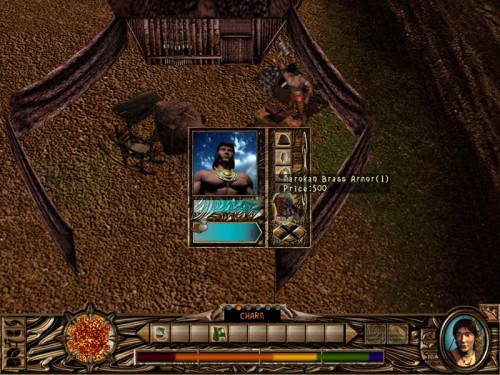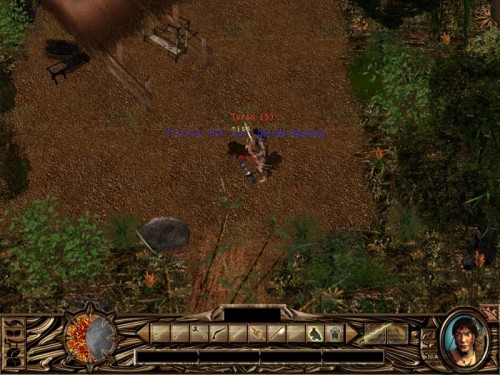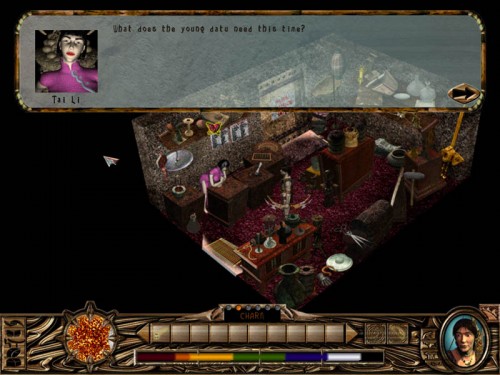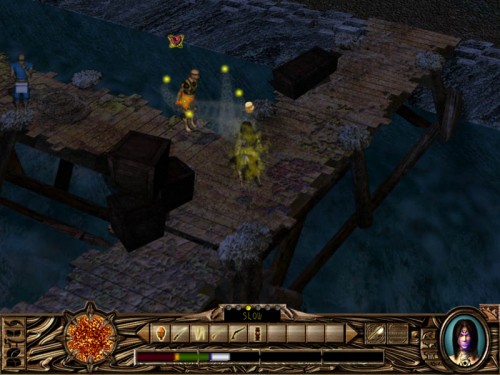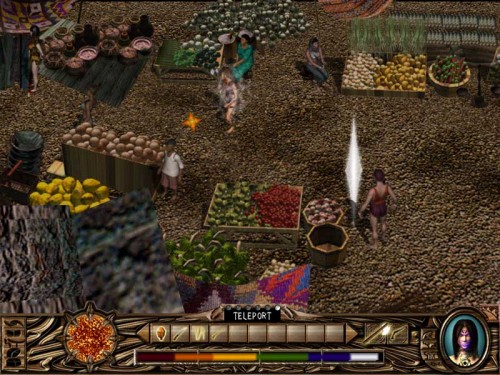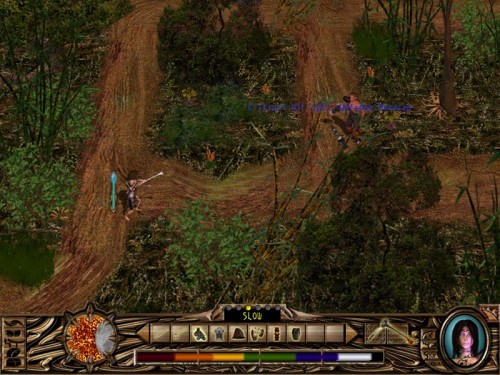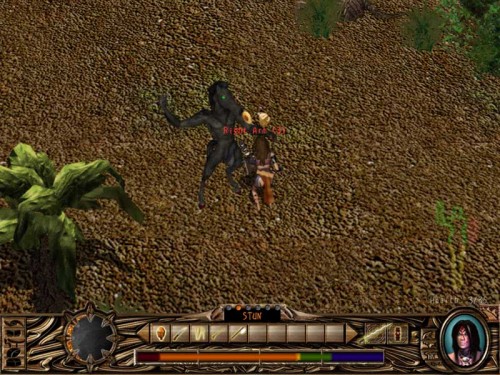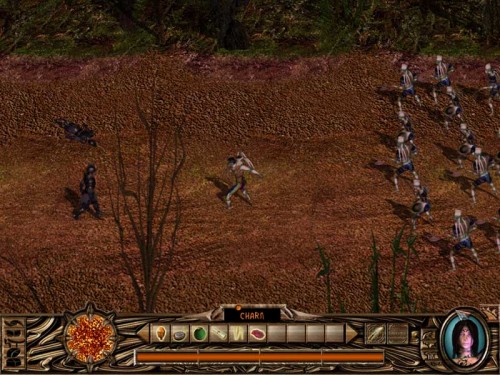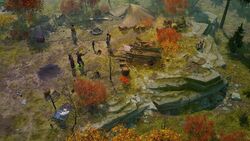Anito Interview
Anito Interview
Codex Interview - posted by Saint_Proverbius on Thu 6 March 2003, 19:01:27
Tags: Anino Entertainment; Anito: Defend a Land Enraged1.) First of all, tell us a little bit about Anino Entertainment. How did you guys get together?
Our story is pretty typical for indie / amateur developers - a bunch of friends still in college doing a bit of research on how to make a game. So there we are poking around with direct X, etc, etc., and a few months later, we have a prototype of a game engine. Although from me and four of my friends, we're now down to two (as the other guys went on to become a doctor and a scholar). That was back in late 2001. After that, it was a matter of finding the right people who had the potential to be good in their jobs(as none of us had any experience, nor had any training beforehand to do what we are doing now). Also, since there are no other game developers(excluding cellphone game makers) in the Philippines, we had to learn everything ourselves. So in the end, it's just a bunch of inexperienced people working their asses off and trying to appear as professional as we possibly can.
2.) CRPGs are fairly hard to develop and do well. What made you want to do a CRPG given the difficulty involved?
One initial challenge in making our first computer game is making it stand out. In our opinion, making a CRPG game was the best way to do that and crack into the highly competitive market. From there, we could inject elements that are unique solely to our game. I'm not talking about going head to head with the likes of Bioware, but more of carving a niche for ourselves. One final reason is that we love CRPG games.
Also, let me state that the game is not a straight-up RPG. You do not have a party, nor can you select a character class at the start. Because the game is also part adventure, the puzzle-solving and story elements are as heavy, as you would have to play a specific role in the storyline.
One of the most difficult challenges we encountered in creating a good RPG was not just the gameplay and technical side, but more on creating the content. Having to weave an involving storyline, and scripting them into non-linear yet rewarding events, is just as hard as creating a game engine from scratch.
3.) Can you tell us a little about Anito's setting? What era is it in? What all does this setting offer the player?
Anito is set somewhere in 16th century Southeast Asia. The era that it belongs to, if we base it on a concrete historical timeline, would be set in the Age of Conquest (after colonization had begun among the islands of the region). "Maroka" is what we call the island where our game takes place. It is a time of exploration and great adventure. Newly opened doors have led us to more closed doors that need to be opened. A new mystery unfolds with each revelation.
Looking closer at our setting, the player would immediately notice a time of darkness and internal turmoil among the inhabitants of the land. There are the conquering outlanders, the merchant race and the native tribes. The interaction of these three races is what makes our story a unique - a story about tolerance, independence, and love for the land.
Because our setting is based on our rich treasury of indigenous folklore, legends and cultural history, we offer the player a variety of locations (from mountain peaks to beaches to jungles to volcanic underground caverns), and environments that contain unique graphics (items, characters, monsters never seen in a video game), inspire fresh music, and spawn interesting puzzles.
4.) How is character creation handled? What types of options are given to the player upon creation?
Character creation in Anito is fairly simple - you simply allocate 7 available statistical points between the four primary attributes (strength, agility, health, energy). This will affect the player's statistics (increasing strength will increase damage, for example), and therefore the way he/she approaches the game. Choosing between the male and female characters in Anito will have a very big effect, unlike in other games where this is mostly a cosmetic decision - the male and female characters have different storylines, different interaction with the people they meet in Maroka, and will have different quests. In a way, you are getting two complete games in one package - Maya's story, and Agila's story.
5.) What skills are present in the game? Can you touch on them a bit? Are skills open to all players? How do they advance?
There are basically 3 types of skills. There are passive skills such as proficiency with weapons. i.e. the shoot skill decreases the time it takes to aim your ranged weapons, therefore improving your refire rate. There are fighting skills, such as stun, and blinding strike. Then there are mind skills, which are sort of like spells in a way. With these, you can summon forest denizens or charm NPCs to make them do what you want. Also, each skill has a unique chakra assigned to it (loosely based on the Indian teaching of chakras), which will tell you where you need to take the energy from. Tentatively there are 28 skills in the game, four for each of the chakras. A unique aspect of the game is that skills and skill ups are acquired through the story. Skill ups are allocatable.
(Note: the zip file I sent has some sample skill descriptions)
6.) What attributes, like strength, intelligence, etc., does the character system have? What part do they play in the game? Are there some gameplay examples of their use?
There are 4 allocatable primary attributes: Strength, Energy, Agility, and Health. Interpreting the statistical points are fairly simple - strength increases a player's damage, so a melee-oriented player would want to raise this. Agility raises a player's defense rating and chance to hit opposing creatures. This is the attribute that all players would want to raise no matter what type of character they want to play. Increasing your health would mean having more hit points (which is always good), and raising your energy level means that you would have more chakra (our equivalent of mana points) to use your skills.
There is no intelligence factor as the character would have to rely on the intelligence of the player to do things for him.
Most attributes are also story based. You would not be able to get a super character simply by killing some monsters a gazillion times.
7.) How is combat handled in the game? Is it turn based, phase based, or real time?
The combat is real time. The game is really not as combat heavy as most RPGs, so the emphasis on combat is also not as big. However, one thing that surprised me was how the testers seem to thoroughly enjoy the unique combat system of the game. It is not simple point-and-click style, but you would have to maneuver your character around to beat the enemies. Options include blocking and strafing, aiming ranged weapons, and quick changing to melee. There are combo and counter attacks and dashing. Also, there are damage to specific body parts and corresponding consequences for each. (e.g. damage to legs means slower movement).
8.) For players who aren't in to a great deal of fighting, are there options to allow those to avoid fighting?
Well, not really. One option would be to select the female character, whose storyline is not as heavy on combat as the male counterpart. However, you will have your nails dirtied at significant points in the game. For the few hand - picked parts you have to be involved in however, the rewards would be satisfying.
9.) One of your features is that players must manage sleep, eating, and hygiene cycles. How is this handled to avoid making it seem like forced micromanagement? How do you think this adds to the gameplay?
Sleeping and eating do not seem like chores at all. Sleeping is provided to speed up the game and get some health and energy regeneration for the body. Also, through sleep, you could pattern your character with a particular town's habits. At night for example, the markets are closed, the forests are scarier, yet the cockfight center is open. It makes for a much more engrossing feel of the game. Although, at your option, you could play through the entire game without getting an ounce of sleep - provided you have enough potions, and provided you have something to do all night long.
As for the eating, you would have to do it only once a day, and there is no shortage of food in the land. The fun in feeding your character is in getting the right combination for unique effects. (I would not want to give too much of this away though.)
As for the hygiene cycles, we scrapped it (which leaves us wondering what to do with the numerous toilets left over).
10.) Can you tell us a little about the type of people we're going to meet up with in the game? The towns? Any interesting factions in the game?
There are different types of people in Anito, and your character can interact with all of them (there are also some 'romantic' possibilities, but I won't get into that yet). Merchants, authorities, townsfolk in need, and hostiles. All characters have dialogue that updates with each plot point.
For specific information (the factions in the game, towns, etc), you can find them in the zip file I sent.
11.) Anito will ship with editors, allowing players to customize the game. Can you tell us a little bit about those editors? What can and can't be altered about the title?
Unfortunately, the editors may not come with the initial release of the game, given the nearing release. It may come with the collector's edition (given the minute chance that we are allowed to make one) or (more likely) as a downloadable on our website.
These tools will include a level builder, an object and animation editor, a dialogue and cutscene editor, an exporter for 3D Studio Max, plus other image manipulation tools for tiling and splicing. With these tools plus your friendly neighborhood Notepad, you may create an entirely new game of your own, as these are also the tools we used to create the game. Create new potions, new villains, new weapons, and a new storyline.
With some knowledge in graphics programs (3DS Max and Photoshop), you may also be able to build your own custom levels. Of course, you may also use the stock art that comes with the game. Take note however that these tools are not for the feint of heart. These are powerful weapons that may be used by the hardcore gamers and amateur developers.
Ah, and the credits cannot be edited.
12.) Your page lists April 2003 as the release date. Are you still on track for that date? Will there be a demo version?
Ouch, April 2003 is not the release date. It is a common misconception (that think I have to do something about). April 2003 is the time we would be finishing the game - so that would internally be our beta version. It will be released hopefully sometime in Q3 if the publishing deal goes well enough. Actually, budget constraints are the ones currently dictating our target date. So whether we like it or not, we would have to finish by that time. I for one would love to have a few months more, just so we could further improve our story and content.
We will have a downloadable demo version. I just hope that our country's poor bandwidth can handle it.
13.) Would there be anything else you'd like to add about Anito? Any points to brag about?
No, not really. We're humble people .
.
One thing you may not be aware of is that our game has a score. This is a throwback to the old adventure games, where story progress is tracked by a scoring system. Our game is a hybrid of role-playing and adventure genres, so we borrowed the concepts from both genres that would fit well with our game and make it unique while at the same time, disposing of other elements that would make the game harder to understand for casual gamers (e.g. leveling up, character classes).
Thanks to Niel Dagondon for taking the time to answer these questions! You're a champ, Niel!
Our story is pretty typical for indie / amateur developers - a bunch of friends still in college doing a bit of research on how to make a game. So there we are poking around with direct X, etc, etc., and a few months later, we have a prototype of a game engine. Although from me and four of my friends, we're now down to two (as the other guys went on to become a doctor and a scholar). That was back in late 2001. After that, it was a matter of finding the right people who had the potential to be good in their jobs(as none of us had any experience, nor had any training beforehand to do what we are doing now). Also, since there are no other game developers(excluding cellphone game makers) in the Philippines, we had to learn everything ourselves. So in the end, it's just a bunch of inexperienced people working their asses off and trying to appear as professional as we possibly can.
2.) CRPGs are fairly hard to develop and do well. What made you want to do a CRPG given the difficulty involved?
One initial challenge in making our first computer game is making it stand out. In our opinion, making a CRPG game was the best way to do that and crack into the highly competitive market. From there, we could inject elements that are unique solely to our game. I'm not talking about going head to head with the likes of Bioware, but more of carving a niche for ourselves. One final reason is that we love CRPG games.
Also, let me state that the game is not a straight-up RPG. You do not have a party, nor can you select a character class at the start. Because the game is also part adventure, the puzzle-solving and story elements are as heavy, as you would have to play a specific role in the storyline.
One of the most difficult challenges we encountered in creating a good RPG was not just the gameplay and technical side, but more on creating the content. Having to weave an involving storyline, and scripting them into non-linear yet rewarding events, is just as hard as creating a game engine from scratch.
3.) Can you tell us a little about Anito's setting? What era is it in? What all does this setting offer the player?
Anito is set somewhere in 16th century Southeast Asia. The era that it belongs to, if we base it on a concrete historical timeline, would be set in the Age of Conquest (after colonization had begun among the islands of the region). "Maroka" is what we call the island where our game takes place. It is a time of exploration and great adventure. Newly opened doors have led us to more closed doors that need to be opened. A new mystery unfolds with each revelation.
Looking closer at our setting, the player would immediately notice a time of darkness and internal turmoil among the inhabitants of the land. There are the conquering outlanders, the merchant race and the native tribes. The interaction of these three races is what makes our story a unique - a story about tolerance, independence, and love for the land.
Because our setting is based on our rich treasury of indigenous folklore, legends and cultural history, we offer the player a variety of locations (from mountain peaks to beaches to jungles to volcanic underground caverns), and environments that contain unique graphics (items, characters, monsters never seen in a video game), inspire fresh music, and spawn interesting puzzles.
4.) How is character creation handled? What types of options are given to the player upon creation?
Character creation in Anito is fairly simple - you simply allocate 7 available statistical points between the four primary attributes (strength, agility, health, energy). This will affect the player's statistics (increasing strength will increase damage, for example), and therefore the way he/she approaches the game. Choosing between the male and female characters in Anito will have a very big effect, unlike in other games where this is mostly a cosmetic decision - the male and female characters have different storylines, different interaction with the people they meet in Maroka, and will have different quests. In a way, you are getting two complete games in one package - Maya's story, and Agila's story.
5.) What skills are present in the game? Can you touch on them a bit? Are skills open to all players? How do they advance?
There are basically 3 types of skills. There are passive skills such as proficiency with weapons. i.e. the shoot skill decreases the time it takes to aim your ranged weapons, therefore improving your refire rate. There are fighting skills, such as stun, and blinding strike. Then there are mind skills, which are sort of like spells in a way. With these, you can summon forest denizens or charm NPCs to make them do what you want. Also, each skill has a unique chakra assigned to it (loosely based on the Indian teaching of chakras), which will tell you where you need to take the energy from. Tentatively there are 28 skills in the game, four for each of the chakras. A unique aspect of the game is that skills and skill ups are acquired through the story. Skill ups are allocatable.
(Note: the zip file I sent has some sample skill descriptions)
6.) What attributes, like strength, intelligence, etc., does the character system have? What part do they play in the game? Are there some gameplay examples of their use?
There are 4 allocatable primary attributes: Strength, Energy, Agility, and Health. Interpreting the statistical points are fairly simple - strength increases a player's damage, so a melee-oriented player would want to raise this. Agility raises a player's defense rating and chance to hit opposing creatures. This is the attribute that all players would want to raise no matter what type of character they want to play. Increasing your health would mean having more hit points (which is always good), and raising your energy level means that you would have more chakra (our equivalent of mana points) to use your skills.
There is no intelligence factor as the character would have to rely on the intelligence of the player to do things for him.
Most attributes are also story based. You would not be able to get a super character simply by killing some monsters a gazillion times.
7.) How is combat handled in the game? Is it turn based, phase based, or real time?
The combat is real time. The game is really not as combat heavy as most RPGs, so the emphasis on combat is also not as big. However, one thing that surprised me was how the testers seem to thoroughly enjoy the unique combat system of the game. It is not simple point-and-click style, but you would have to maneuver your character around to beat the enemies. Options include blocking and strafing, aiming ranged weapons, and quick changing to melee. There are combo and counter attacks and dashing. Also, there are damage to specific body parts and corresponding consequences for each. (e.g. damage to legs means slower movement).
8.) For players who aren't in to a great deal of fighting, are there options to allow those to avoid fighting?
Well, not really. One option would be to select the female character, whose storyline is not as heavy on combat as the male counterpart. However, you will have your nails dirtied at significant points in the game. For the few hand - picked parts you have to be involved in however, the rewards would be satisfying.
9.) One of your features is that players must manage sleep, eating, and hygiene cycles. How is this handled to avoid making it seem like forced micromanagement? How do you think this adds to the gameplay?
Sleeping and eating do not seem like chores at all. Sleeping is provided to speed up the game and get some health and energy regeneration for the body. Also, through sleep, you could pattern your character with a particular town's habits. At night for example, the markets are closed, the forests are scarier, yet the cockfight center is open. It makes for a much more engrossing feel of the game. Although, at your option, you could play through the entire game without getting an ounce of sleep - provided you have enough potions, and provided you have something to do all night long.
As for the eating, you would have to do it only once a day, and there is no shortage of food in the land. The fun in feeding your character is in getting the right combination for unique effects. (I would not want to give too much of this away though.)
As for the hygiene cycles, we scrapped it (which leaves us wondering what to do with the numerous toilets left over).
10.) Can you tell us a little about the type of people we're going to meet up with in the game? The towns? Any interesting factions in the game?
There are different types of people in Anito, and your character can interact with all of them (there are also some 'romantic' possibilities, but I won't get into that yet). Merchants, authorities, townsfolk in need, and hostiles. All characters have dialogue that updates with each plot point.
For specific information (the factions in the game, towns, etc), you can find them in the zip file I sent.
11.) Anito will ship with editors, allowing players to customize the game. Can you tell us a little bit about those editors? What can and can't be altered about the title?
Unfortunately, the editors may not come with the initial release of the game, given the nearing release. It may come with the collector's edition (given the minute chance that we are allowed to make one) or (more likely) as a downloadable on our website.
These tools will include a level builder, an object and animation editor, a dialogue and cutscene editor, an exporter for 3D Studio Max, plus other image manipulation tools for tiling and splicing. With these tools plus your friendly neighborhood Notepad, you may create an entirely new game of your own, as these are also the tools we used to create the game. Create new potions, new villains, new weapons, and a new storyline.
With some knowledge in graphics programs (3DS Max and Photoshop), you may also be able to build your own custom levels. Of course, you may also use the stock art that comes with the game. Take note however that these tools are not for the feint of heart. These are powerful weapons that may be used by the hardcore gamers and amateur developers.
Ah, and the credits cannot be edited.
12.) Your page lists April 2003 as the release date. Are you still on track for that date? Will there be a demo version?
Ouch, April 2003 is not the release date. It is a common misconception (that think I have to do something about). April 2003 is the time we would be finishing the game - so that would internally be our beta version. It will be released hopefully sometime in Q3 if the publishing deal goes well enough. Actually, budget constraints are the ones currently dictating our target date. So whether we like it or not, we would have to finish by that time. I for one would love to have a few months more, just so we could further improve our story and content.
We will have a downloadable demo version. I just hope that our country's poor bandwidth can handle it.
13.) Would there be anything else you'd like to add about Anito? Any points to brag about?
No, not really. We're humble people
One thing you may not be aware of is that our game has a score. This is a throwback to the old adventure games, where story progress is tracked by a scoring system. Our game is a hybrid of role-playing and adventure genres, so we borrowed the concepts from both genres that would fit well with our game and make it unique while at the same time, disposing of other elements that would make the game harder to understand for casual gamers (e.g. leveling up, character classes).
Thanks to Niel Dagondon for taking the time to answer these questions! You're a champ, Niel!




